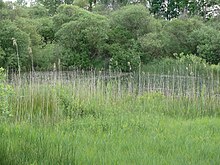Erdinger moss
The Erdinger Moos is a moorland between Erding and Freising , which, apart from small parts in the Freising district , is mostly located in the Erding district. The Erdinger Moos includes the municipality of Oberding , smaller parts of the large district town of Freising, the municipality of Hallbergmoos , the southern part of the municipality of Marzling , as well as the municipalities of Eitting , Berglern and Moosinning and parts of the city of Erding and Fraunberg . In the area of the Erdinger Moos, the Munich Franz Josef Strauss Airport is located in roughly equal parts in both districts . It is part of the Munich green belt .
Geologically, the moss is the continuation of the Munich gravel plain and is located to the right of the Isar. To the left of the Isar are the Freisinger Moos and Dachauer Moos . The water balance in the moss was mainly determined by the Isar . The Middle Isar Canal crosses the Erdinger Moos from south to north.
The Viehlaßmoos nature reserve (NSG-00175.01, Niedermoor , 244.33 ha) is located in the area of the communities of Eitting and Berglern . The nature reserve Zengermoos (NSG-00491.01, birch forest ecosystem, 252.6 ha) is located southeast of Hallbergmoos, in the area of the municipality of Moosinning. Also in the municipality of Moosinning there is the Gfungach nature reserve (NSG-00379.01), with a size of 6.7 ha and at the same time the oldest nature reserve in Bavaria.
history
From the 8th century onwards, agricultural use with litter extraction and grazing began; it also served as a hunting area. Until the secularization of 1802/1803 the western part - a strip along the Isar - belonged to the Hochstift Freising , the area east of it belonged to the Duchy / Electorate of Bavaria. The original name of this fen area was "Isarmoos", "Freisinger Moos" and "Erding-Freisinger-Moos"; today's name "Erdinger Moos" has only been in use since the 19th century.
The original character of the moss was largely retained until the beginning of the 19th century. Only drainage measures and peat extraction led to the reclamation of the area towards the end of the 19th century . Around 1930 only 23 square kilometers, i.e. about ten percent of the original area of the Erdinger Moos, were not cultivated. Although the Erdinger Moos was sparsely populated before the airport was built, the surrounding, densely populated north of Munich, with the development axis Munich- Freising - Moosburg - Landshut along the Isar , was affected by aircraft noise, infrastructure measures and settlement pressure due to the relocation of the airport . Apart from that, the residents of Franzheim and partly also from Schwaigermoos had to be resettled, especially for the construction of the runways . The construction work for the opening of the new Munich II airport then resulted in a noticeable lowering of the groundwater level.
Web links
- Florian Sepp / Claudius Stein, draining the Erdinger Moos, in: Historisches Lexikon Bayerns
Individual evidence
Coordinates: 48 ° 21 ' N , 11 ° 51' E

